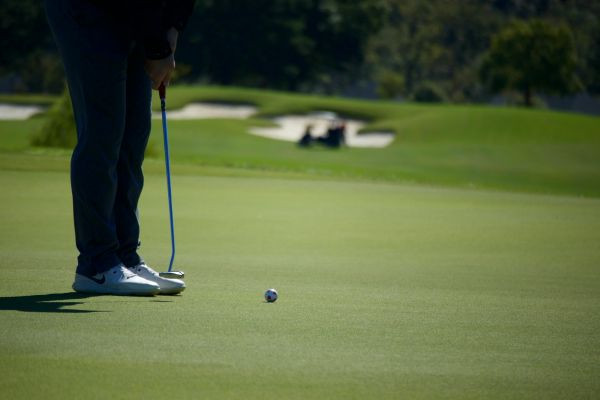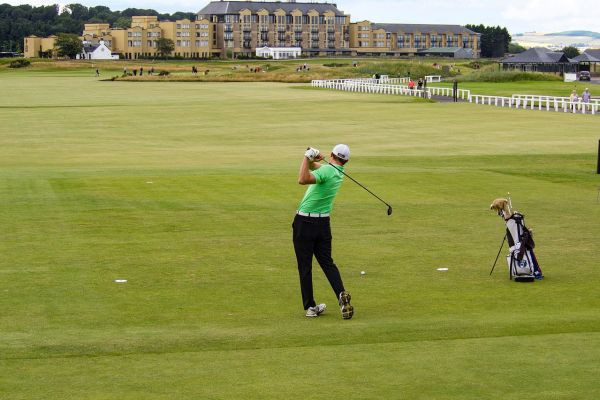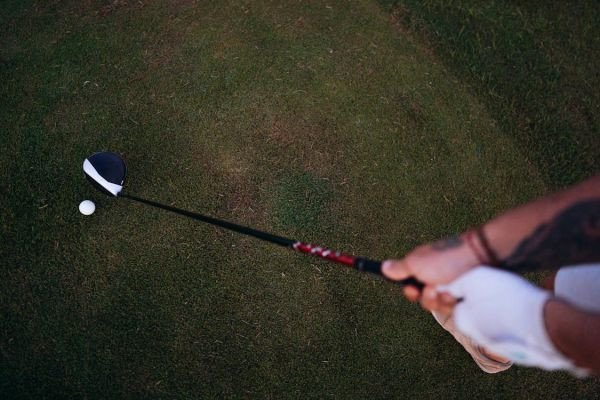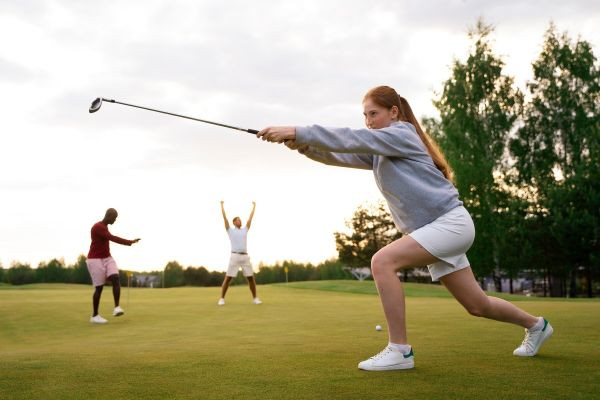Ultimate Guide to Eliminating Your Golf Slice for Good
Let's face it, nobody likes to see their golf ball veering off to the right, forming that dreaded curve away from the fairway. It's called a slice, and it's one of the most common issues plaguing amat..

Let's face it, nobody likes to see their golf ball veering off to the right, forming that dreaded curve away from the fairway. It's called a slice, and it's one of the most common issues plaguing amateur golfers around the globe. But what exactly is a slice? Simply put, it's when the ball starts off to the left (for right-handers) and then dramatically curves to the right in mid-air, often ending up far from where you intended.
Why focus on fixing your slice? Besides the obvious frustration it causes, slicing can severely impact your game, reducing distance and accuracy and putting you in challenging positions on the course. By conquering your slice you'll not only improve your scores but also enjoy your game much more. Let's dive into how you can achieve this transformation.
The Fundamentals
The Grip
A common culprit behind a persistent slice is the grip. A weak grip where the hands are positioned too far towards the lead side of the club can cause the clubface to open at impact, sending the ball veering off to the right. To self-assess, take your stance and look down at your hands. How many knuckles can you see on your lead hand? If you see fewer than two your grip may be too weak predisposing you to that unwanted slice.
Danny Maude, a respected voice in golf coaching, often stresses the importance of adopting a stronger grip to combat the slice. This advice doesn't suggest applying more pressure on the club; instead it's about repositioning your hands. For a right-handed golfer this means rotating your left hand to the right so that you can see more of its knuckles — ideally at least two or three. Your right hand should come more underneath the club supporting it. This grip adjustment encourages the clubface to close more effectively upon impact promoting a straighter flight path.
Stance and Posture
Your stance is the foundation of your golf swing setting the trajectory for every shot. A common mistake that leads to slicing is improper alignment with feet, hips or shoulders not parallel to the target line. This misalignment often leads to compensations in the swing that open the clubface. To ensure proper alignment use alignment sticks on the ground when practicing. They provide a visual guide to keep your stance in check ensuring everything is aimed right where you intend to hit the ball.
A dynamic, powerful and precise golf swing is built on the foundation of the correct posture. The goal is to establish a posture that is both athletic and balanced. This starts with bending at the hips not the waist. Imagine tilting your upper body forward from the hip joints while keeping your spine straight. This position allows for optimal rotation and power generation during the swing. Your knees should be slightly bent and your weight evenly distributed across the balls of your feet ready to move dynamically through the swing. A relaxed back rather than a tense one facilitates a fuller turn and better energy transfer through the ball.
When you make these changes to how you hold the club, position yourself and stand, it isn't just about fixing your slice; it's about laying the foundation for a golf game that's more reliable, powerful and precise. Practice these basics consistently. You'll not only see fewer slices but also an overall enhancement in your shots. Always remember that good golfing begins even before you swing the club – it starts with getting your setup right.
The Swing Mechanics
The Backswing
Chris Ryan emphasizes how crucial the backswing is in preparing for a downswing. One common mistake is not turning the hips and legs enough. This oversight can lead to a swing path that increases the chances of slicing.
A helpful suggestion to enhance your backswing involves paying attention to your glove logo. Making sure this logo faces upward at the peak of your backswing can help create a better path for your downswing. This tweak can significantly reduce the risk of making an over the top swing, which often leads to slicing.
Transition and Downswing
The moment when you transition from backswing to downswing is pivotal. Many amateur golfers tend to start their downswings with their arms or shoulders which is a frequent mistake.
This method often leads to the mistake of a swing resulting in a slice. An effective approach involves starting the downswing, with a hip rotation towards the target. This action promotes an inside out swing path, which is crucial for getting rid of the slice.
Thinking of your golf swing like a baseball swing on a tilted plane can be helpful. The goal is to guide the club on this plane during the downswing. Chris Ryan suggests imagining that you're swinging towards the field (for right handed golfers). This mental image encourages an inside out swing path effectively combating the slice.
The Follow-Through
The follow through is just as important as any part of your swing. It signals a release and complete body rotation. At the end of your swing your chest should face the target and your right foot should rise to balance on your toe. This position confirms that you've fully rotated through impact with the ball. Consistently achieving this posture is crucial for eliminating slicing, from your game.
Advanced Tips from the Pros
Danny Maude
Danny Maude stresses how critical it is to focus on your finishing position. Many golfers make an error by finishing their swing with their weight on the back foot causing a lack of proper rotation when hitting the ball. This mistake is often associated with slicing shots. Danny's advice is simple yet effective; focus on your finishing position. Make sure your weight shifts forward and your body faces the target. By making this adjustment you can significantly enhance your swing mechanics. Minimize slicing issues.
Chris Ryan
Chris Ryan shares tips on improving the backswing. Creating depth during the backswing is crucial, for establishing an inside out swing path. Chris suggests aiming to have the club's grip end pointing towards the ground at the apex of your backswing. This technique helps position the club behind you, which aids in achieving the desired swing path. Practicing this adjustment can help you eliminate slices from your game.
Nick Faldo
Nick Faldo provides tips for improvement on the course. Making an adjustment to close your stance can correct your swing path towards an inside-out direction, which is key for addressing slicing problems. Additionally Nick emphasizes the significance of how the lead shoulder moves and how to release the trail arm through impact.
Practicing these techniques can help you keep your clubface square at impact reducing the chances of slicing. Following Sir Nick's advice may result in improvements and better performance.
Practice Makes Perfect
Drills for a Better Grip
A solid grip is essential for a golf swing. You can work on this when you're not at the golf course. Practice gripping your club at home to build muscle memory. This routine will make holding the club correctly feel natural when you're out on the course leading to control and decreased slicing tendencies.
Exercises for Improving Swing Path
Using alignment sticks is key for refining your swing path. Place one stick parallel to your target line and another angled at 45 degrees in the direction you want your club to follow through. This setup promotes an inside out swing path avoiding the outside in trajectory that often leads to slicing. Practicing with these aids can make positive changes to your swing mechanics.
Using Technology to Track Progress
Utilizing the advancements in golf training technology, such as launch monitors and swing analyzers can enhance your practice sessions. These tools offer real time feedback on your swing technique, clubface position and ball trajectory allowing you to make adjustments and track your progress over time effectively.
Equipment Check
When striving to improve your game by reducing slices it's essential to consider the equipment you use including your driver. Not all drivers are suitable for every golfer, especially those dealing with slicing issues. Some drivers are designed with features that help promote a straighter ball flight. Seeking assistance from a club fitter can guide you in selecting the driver tailored to minimize slicing and elevate your performance on the course.
In addition to choosing the right driver a thorough club fitting session can evaluate how well your current set of clubs aligns with your swing mechanics and slicing concerns. A professional fitting assesses factors like shaft flexibility, club length and line angle—all of which play a role in shaping your swing pattern and influencing the ball's flight path. Understanding and optimizing these elements can greatly decrease slicing making club fitting a part of refining your golf abilities.
Conclusion
Correcting your slice won't happen instantly. With the right strategy and regular practice it is certainly attainable. Concentrate on mastering the basics and incorporate advice from professionals. Utilize all resources, including practice routines and suitable gear. Keep in mind that achieving a game without slices is more of a process, than a quick fix. Stay persistent, maintain an attitude and savor the journey.
Frequently Asked Questions (FAQs)
What is the fastest way to fix a slice?
The quickest way to fix a slice is by fixing your grip and alignment / stance. These two things impact your clubface position at impact. The club face is the biggest factor in correcting the slice.
Can changing my driver reduce my slice?
Yes, changing your driver to one that is fitted for your swing can help reduce your slice. The correct driver features can help produce a straighter ball flight. Drivers that are adjustable with weights are also effective. If you have a bad slice, make one of your weights heavy neutral and make the other one light draw biased.
How often should I practice to eliminate my slice?
Consistent practice is the key to eliminating your slice. Set a goal of often you can practice your swing adjustments and drills 3-4 times a week on the higher side, working on a repeatable inside-out swing path and fix any grip or stance issues.
Is it possible to fix a slice without professional help?
While one’s improvement can be expedited through professional help, a slice can most definitely be fixed on one’s own by consistently applying the correct techniques and adjustments, such as improving the grip, stance, and swing path, as well as applying practice aids and technology for feedback.
How does grip affect my slice?
A weak grip is characterized by the visibility of one or at most two knuckles.. A weak grip often causes the clubface to be open at impact, which means the ball will be slicing. So to correct my slice I would need to see less knuckles at address.
Why do I slice my driver but not my irons?
Slicing the driver but not the irons is one of the most frustrating challenges in golf. This is common because of the lower loft on the club along with the length of the driver. The longer length and lower lofts of a driver compared to irons are more susceptible to exhibiting ball flight flaws (ie. open clubface, outside-in swing plane). The lofts of irons inherently assist in counteracting these flaws resulting in straighter shots.
Can a slice be fixed overnight?
Although acquiring the correct information can sometimes lead to significant improvements, eliminating your slice usually requires time and consistent practice. You could have hours of practice and switch the next day to a slice still. I didn't mean you will never get rid of this slice, what I meant was you have to keep going through the process of fixing it and eventually it gets fixed.








































































